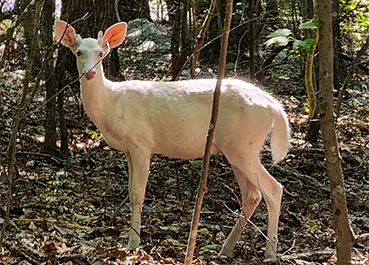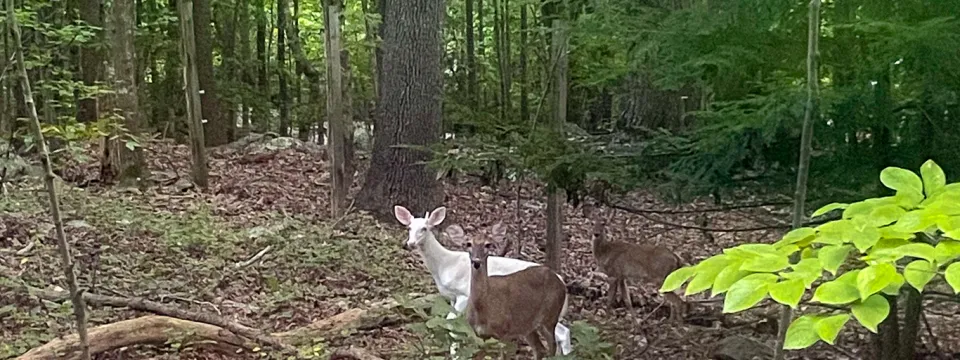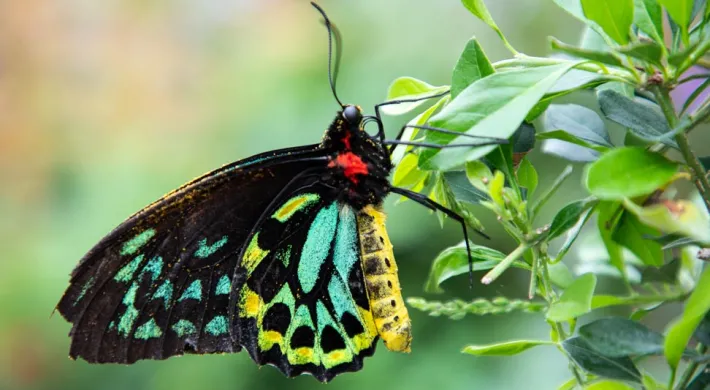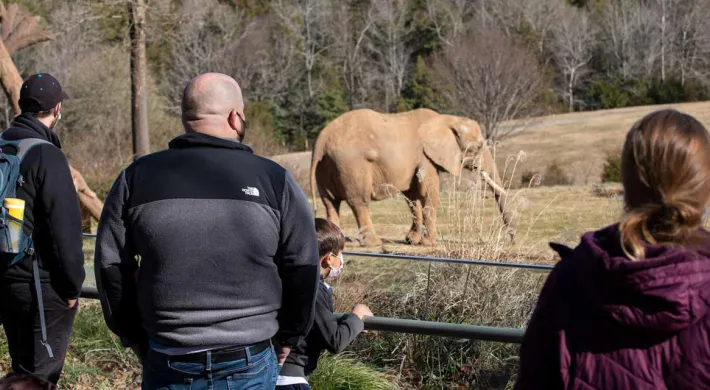The Miraculous White Deer of the North Carolina Zoo
Written by Jayne Parker, North Carolina Zoo Society, and Diane Villa, North Carolina Zoo
It’s a fact: the North Carolina Zoo is a “zoo,” and wild things happen here all the time. But the recent appearance of a native white deer? Whoa!
Yet hold on…the plot thickens. You may have heard or even read Nicholas Sparks’s recently released novel, Counting Miracles. The story is set in Asheboro, includes a passage about visiting the North Carolina Zoo, and oddly enough (spoiler alert!) weaves a white deer into the storyline. The fact that this novel was released in the same year that a white deer appeared at the Zoo is pretty cool!
Staff Monitor Native Wildlife at the North Carolina Zoo and Discover a White Deer
Here’s how we discovered our white deer: Zoo staff pay attention to the native animals that live with us here in the Heart of North Carolina. Our mission calls for the protection of wildlife and wild places. Wildlife cameras document bobcats, foxes, and other native species as they wander inside the enormous Park. The photographs keep staff updated on the health and stability of our local wildlife populations.
In addition to these cameras, we watch out for local wildlife, too. When employees see an unusual animal or activity, they share it with their coworkers. The more unusual a sighting, the faster the news spreads. Just this past spring, one of these sightings turned into a super-buzz that raced around the park: a snow-white fawn was seen trotting along with the Zoo’s resident herd of wild deer. Employees who were lucky enough to see the small white fawn were the envy of their coworkers. More and more staff confirmed seeing the little guy—everyone commenting how striking it is to see his big pink ears and brown eyes set against his pure white body.
Well known to staff, this resident herd of white-tailed deer routinely crisscrosses a 20-to-30-acre stretch of land located safely inside the park’s fenced boundaries, located in Randolph County. This “Zoo herd” has lived on the property for as long as anyone can remember. For years, the deer in the herd have been color-typical: brown in summer and slightly grayer in winter. So, the sudden arrival of a striking white fawn delighted everyone. To some Zoo old-timers, it was not entirely a surprise. Some Zoo employees recall seeing a white deer on the Zoo property back in the late 1990s.
As far as we can tell, the Zoo’s young white male deer seems to be doing well. “Seems” is the operative word because this fellow, like the rest of the herd, is seldom seen. White-tailed deer are crepuscular—most active just before and just after dusk and dawn—the hours when locked perimeter fences prevent guests and most employees from entering the park. That means the Zoo’s second and third-shift rangers, who patrol and protect the property 24 hours a day, have the best chance of seeing this special white deer.
So What Made This Whitetail Deer White?
At the most basic level, the Zoo’s fawn looks white for the same reason that polar bears or any white mammal appear white. Its fur lacks the pigments it needs to give it color.
A small family of pigments—called “melanins”—add color to mammals’ skin, fur, hair, eyes, and other tissues. One member of the family, the eumelanins, tints hair and other cells black or brown. The other, rarer family member, phaeomelanin, supplies the reddish pigment that colors auburn hair, ginger cats, and freckles.

Mammals produce these pigments in special cells called “melanocytes.” If all goes well with these melanocytes, mammals assume the colors typical of their species. But if something goes amiss, the affected tissue—skin, hair, eyes, etc—will not contain pigments and will look white or very pale to us. In the case of our fawn, something has gone amiss with its melanocytes.
It’s important to recognize that not all white fur results from a mishap. Many mammal species have DNA that purposely deactivates some of their melanocytes. That’s what happens with polar bears. They benefit from the camouflaging effects of white fur in the Arctic snow, so their fur’s melanocytes don’t produce any pigment, while their skin’s melanocytes churn out enough melanin to turn their noses and skin black. Something similar happens in zebras, giraffes, and other mammals that have white spots or stripes. Their melanocytes are programmed to switch off and on in sequences that produce the patterns that we see.
Where white fur or hair is not the norm, the lack of color results from faulty melanin production. In rare instances, this fault stems from a mutation that scrambles the recipe cells need to follow to make melanin. Mammals with this mutation cannot produce any pigment and have white hair with pale skin and eyes. Called “albinism,” this condition is rare among wild animals but can be nearly universal in selectively bred strains of show animals, like the Cadbury bunny’s ancestral line.
Only about one out of every 30,000 white-tailed fawns are albinos. Unfortunately, most of these fawns die young. They cannot hide from predators, and because their eyes lack protective pigments, they don’t see very well. They are sensitive to light and have trouble detecting movement.
The Zoo’s white whitetail is not an albino. We know that he can produce melanins because he has brown eyes and a sweet brown muzzle. That tells us that his melanocytes carry the correct recipe for producing melanins, but for some reason, some of his melanocytes didn’t show up everywhere they were supposed to. They made it to his eyes, ears, and nose but are missing from the hairs on his body.
This condition, known as “leucism” or “piebaldism,” occurs more frequently than albinism. About 1 out of every 1,000 whitetail fawns exhibit some degree of leucism. Some of them, like the Zoo herd’s white fawn, are white all over, while others are white in some places and brown in others. The spotted deer are usually called “piebald” deer.
Some leucistic deer have accompanying skeletal deformities that can shorten their lifespans, but these are not present in the Zoo’s white fawn. With luck, he can enjoy a relatively normal life in the safety of his Zoo herd.
We are Counting Miracles
We are grateful for our special white deer and the inspiration he symbolizes. And, if you are a fan of the author Nicholas Sparks, we invite you to Asheboro and the North Carolina Zoo to enjoy a slice of our Randolph County home served with a welcoming smile. Will you see the special white deer? Probably not. Rather, know that he is here, safe and sound and living his best, miraculous life!





